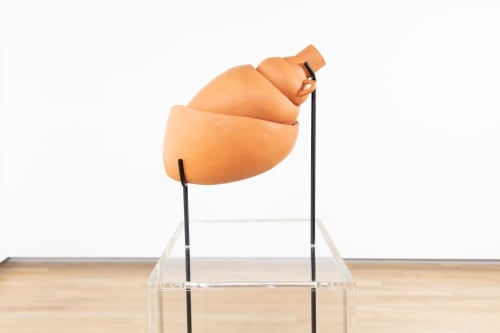Cammie Staros has a thing for antiquities. Her work frequently plays with classical tropes—sometimes as subtle jabs at the Western canon and sometimes as clever commentary on her own Greek heritage. What Will Have Being, her current exhibition at Shulamit Nazarian, charges these conceits with a well-timed existential resignation. It’s no coincidence that the title riffs on the oft-quoted opening lament in the book of Ecclesiastes: “What has been will be again, what has been done will be done again; there is nothing new under the sun.” Like this Old Testament verse, Staros’ three-room exhibition calls out the limited shelf-life of civilizational achievements, saving its most elegant critique for the Western Enlightenment-era systems of classification we’ve used to demystify and rule the unknown.
Given Staros’ interest in the West’s fraught and fragile authority, it is ironic that the show presents as a museological exhibition, using a ruling civilization’s relentless urge to narrativize itself as a tool of critique. Organized by theme and color-calibrated mood lighting, each room foregrounds a different site of reclamation. The first gallery channels the shore, where fastidiously pedestaled objects appear frozen mid-metamorphosis, as if unraveling from terracotta vessels into seashells. Mutatio naturalis (2020), a coiled, mollusk-like urn, pokes fun at the scientific surety of the Latin binomial nomenclature used to classify all living things; upon translation, the title provides only a generic description of the vessel’s shifting natural form. Pincer-like steel mounts enclosed in a Plexiglas box cradle the vessel’s neck and body, clinically displaying it for the viewer’s examination and vividly contrasting the pre-industrial materials of a studied civilization against the mass-produced display instruments of a dominant one.
The next room, accented with blue and green neon rods, conjures the sea. Three larger earthenware vessels, each submerged in its own three-foot aquatic vitrine, repose among lilies and lava rocks while goldfish and minnows swim between their handles. Playing on both Romantic tropes of civilizational ruin and Matrix-style incubators of dystopian science fiction, Staros’ terracotta forms appear (as they do in the first room) in provocative states of mutation, yet now, absorbing mythical characteristics latent in their submarine environments. Where one might expect to see classical details, Sculptura liquefacta (2021) is covered with patterned scales, making the supine object look less like a Hellenistic wine jug and more like a great marooned fish. A shrunken neck and distended body transform Futurum fluidum (2021) from a classical amphora into a sensuous form resembling a prehistoric fertility deity. As the recognizable benchmarks of historical eras melt away in each of Staros’ vessels, their human origins become increasingly nebulous; they invent alternative mythologies of their own.
In the third room, removed from the daylight seeping through the gallery’s front window and duskily lit with pink neon bars, the anatomical features of Staros’ works become spookily, preternaturally pronounced. The twisted neck of Amphora conchata (2020), fastened to the wall with thin steel ropes, echoes the aortic arch of the human heart. The shape of Concha clavata (2021) plays on the teets of the famous Etruscan bronze, the Capitoline Wolf that suckled the mythological twins Romulus and Remus. Yet peering inside the hollow, stylized ceramic construction reveals sharp porcelain teeth, revealing a darker take on Roman civilization’s foundational story.
The inherently narrative framework of any museological exhibition lends itself to allegorizing; it’s hard not to see these objects as metonyms for human existence, on its way to extinction. Yet exploiting the exhibition model asks us to reexamine the systems of naming and classifying so essential to knowledge production, suggesting that the supposedly unassailable boundaries between nature and culture, and history and myth, are not as airtight as they seem. Ultimately, What Will Have Being asks what we’re left with when culture is rubbed out of the archeological record, suggesting that civilization’s drive to name, organize, rule, and propagate originate in the substance of the body itself.
Cammie Staros: What Will Have Being runs from January 16–March 6, 2021 at Shulamit Nazarian (616 N. La Brea Ave., Los Angeles, CA 90036).

